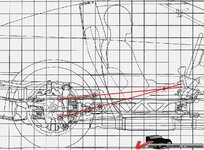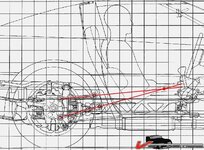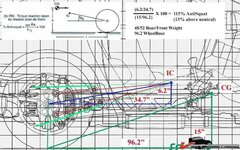Stroker-427
Well-known member
First of all in 90% of cases the upper arm should be some 30% shorter than the lower one.... this will give you some bump camber gain.
Theoretically you need same camber gaing than the roll angle you will have, in order to keep the angle between tire and ground constant.
I allways like to have more camber gain than body roll because the more roll mean higher side load (assuming constant your roll stifness) with the consequent higher tire wall deflection.
Unless you will use your car at the strip, the longitudinal link angle isn't a big concern.
As I told you before the antisquat in a race is important only one time (at the start)..... otherwise the wheel hop when braking will be important before each corner! ;-)
Back to the toe link..... the lenght is only a small one of the parameters of a well designed suspension.
The bump steer will be conditioned by the lenght of the links, by the position of the internal pivot points and even by the king pin angle of your spindle (relative position of the external pivot positions).
Many many different configurations will give you the same bump steer result.
By the way the more important parameter of ANY suspension is the movement of the roll center according with the suspension stroke.
You will have to design a system able to warrant a minimal side travel of the roll center and, as a second issue, an acceptable vertical movement of the roll center in relation to the ground level (this thing is less important).
Only now you can define the correct toe link to warrant the correct roll steer (which is not allways zero roll steer) according with the combo above defined.
As per engines, in this job you will be allways in the "short blanket" condition:
If your nose is well covered, your feet will not....
If your feet are well covered, you will freeze your nose !
Is easy to believe in that, because on the contrary any race car will have the same suspension design!
The job is to obtain the best compromise for your needs!!!!!
Theoretically you need same camber gaing than the roll angle you will have, in order to keep the angle between tire and ground constant.
I allways like to have more camber gain than body roll because the more roll mean higher side load (assuming constant your roll stifness) with the consequent higher tire wall deflection.
Unless you will use your car at the strip, the longitudinal link angle isn't a big concern.
As I told you before the antisquat in a race is important only one time (at the start)..... otherwise the wheel hop when braking will be important before each corner! ;-)
Back to the toe link..... the lenght is only a small one of the parameters of a well designed suspension.
The bump steer will be conditioned by the lenght of the links, by the position of the internal pivot points and even by the king pin angle of your spindle (relative position of the external pivot positions).
Many many different configurations will give you the same bump steer result.
By the way the more important parameter of ANY suspension is the movement of the roll center according with the suspension stroke.
You will have to design a system able to warrant a minimal side travel of the roll center and, as a second issue, an acceptable vertical movement of the roll center in relation to the ground level (this thing is less important).
Only now you can define the correct toe link to warrant the correct roll steer (which is not allways zero roll steer) according with the combo above defined.
As per engines, in this job you will be allways in the "short blanket" condition:
If your nose is well covered, your feet will not....
If your feet are well covered, you will freeze your nose !
Is easy to believe in that, because on the contrary any race car will have the same suspension design!
The job is to obtain the best compromise for your needs!!!!!
Last edited:








